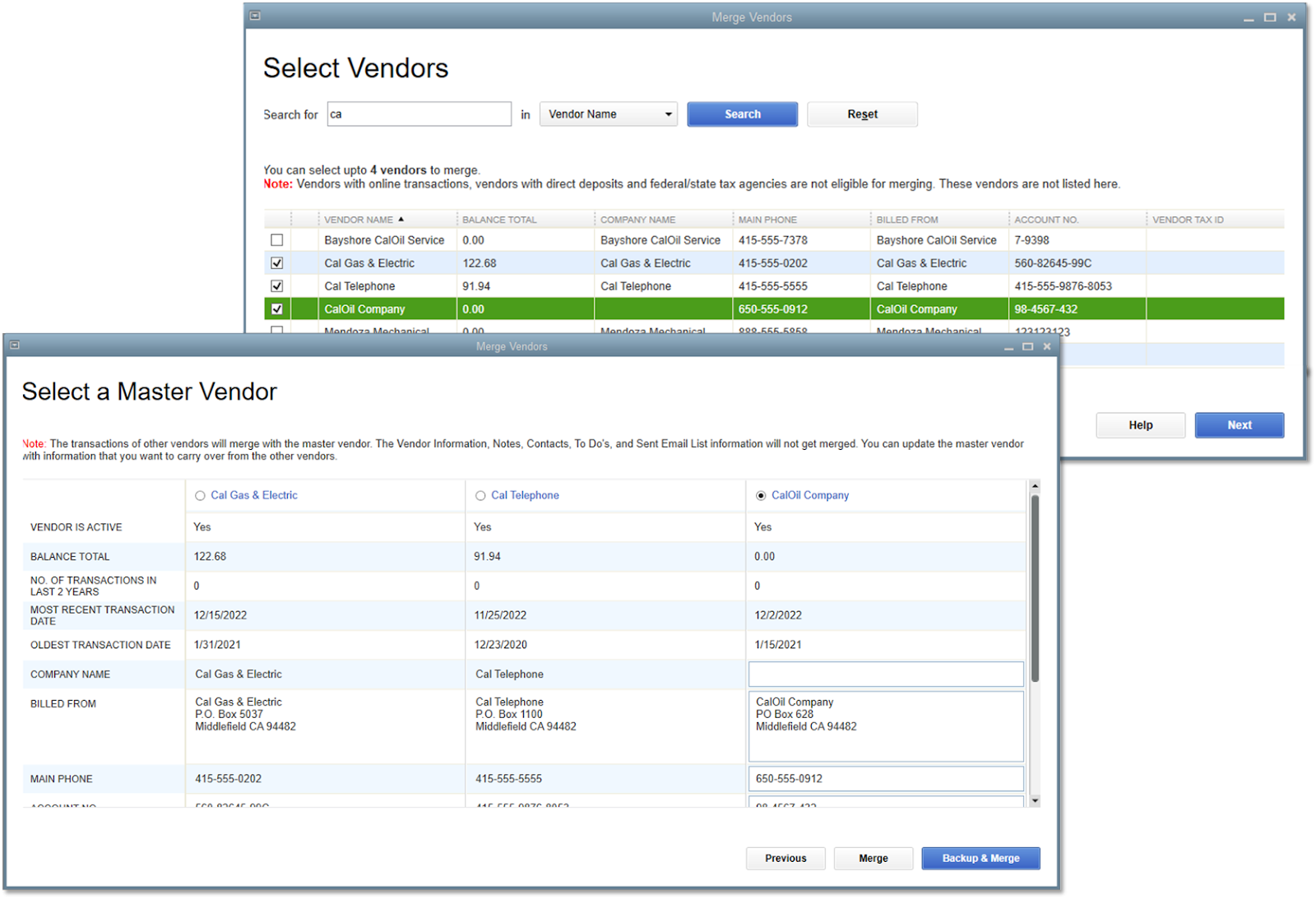To merge vendors in QuickBooks, go to the Vendor Center, select the vendors to merge, and click Merge. Merge vendors in QuickBooks to streamline your accounts payable process, reduce duplicate entries, and improve reporting accuracy.
By consolidating vendors, you can simplify your financial records and make it easier to track expenses effectively. This process helps avoid confusion and ensures that all vendor transactions are properly recorded. Additionally, merging vendors can save time and effort by eliminating the need to manage multiple entries for the same vendor.
Follow these steps to merge vendors seamlessly in QuickBooks and optimize your accounting practices for greater efficiency.

Credit: quickbooks.intuit.com
Why Merge Vendors?
Why Merge Vendors?
When managing your business accounts, you may encounter duplicate vendors in your QuickBooks system. Merging vendors can help streamline your reporting and analysis, making it easier to manage and review your financial data. By consolidating vendor records, you can eliminate confusion and enhance the accuracy of your financial reporting, ultimately saving time and improving decision-making processes.
Duplicate Vendors
Dealing with duplicate vendors can lead to inconsistencies in your financial records. This may result in errors, such as duplicate payments or missed payments, which can affect your company’s financial health. By merging vendors with similar details into a single vendor record, you can avoid confusion and ensure that all transactions are accurately recorded under the correct vendor.
Streamline Reporting And Analysis
Merging vendors can simplify financial reporting and analysis. Combining vendor data allows for clearer visibility into your spending patterns, making it easier to identify opportunities for cost savings and efficiency improvements. It also streamlines the process of preparing vendor reports, saving time and enhancing the overall quality of your financial analysis.
Steps To Merge Vendors
Merging vendors in QuickBooks can help streamline your accounting process and eliminate duplicates. Follow these steps to efficiently combine vendor information.
Review Vendor List
- Access your vendor list in QuickBooks.
- Identify vendors with similar or duplicate names.
- Review vendor details and transactions carefully.
Check For Duplicate Transactions
- Scan through transactions for each vendor.
- Look for duplicate entries or payments.
- Ensure all transaction details are accurate.
Combine Information
- Select the main vendor to merge duplicate entries.
- Choose the secondary vendor to combine with the main one.
- Confirm merging details and proceed with the merge.
Update Related Transactions
- Review past transactions linked to the merged vendors.
- Update any relevant documents or payment records.
- Ensure all financial information remains accurate.
Considerations And Best Practices
Discover the best practices and considerations for merging vendors in QuickBooks. Streamline your accounting processes and ensure accurate financial reporting with these expert tips. Simplify vendor management and enhance your bookkeeping efficiency today.
Backup Your Data
Before merging vendors in QuickBooks, backup your data to prevent any loss of important information.
Merge Similar Vendors
Identify and merge similar vendors to avoid confusion and streamline your accounting records.
Notify Stakeholders
Notify stakeholders about the vendor merging process to keep them informed and ensure transparency.
Reconcile Accounts
After merging vendors, reconcile accounts to maintain accurate financial records and ensure consistency.

Credit: quickbooks.intuit.com
Potential Challenges And Troubleshooting
Troubleshooting potential challenges with merging vendors in QuickBooks can be a daunting task. Ensure a smooth process by carefully reviewing your vendor lists, consolidating duplicate accounts, and updating relevant information.
Loss Of Historical Data
When merging vendors in QuickBooks, one potential challenge is the loss of historical data. This can create discrepancies in financial records and reports. To address this issue, it’s essential to back up your data before initiating the merge.
Matching Transactions
Another issue that may arise when merging vendors is the difficulty in matching transactions. Merging vendors can lead to mismatches in transaction records, causing confusion in reconciling accounts. To troubleshoot this, ensure that all transactions are accurately categorized and reconciled post-merge.
Reprinting Checks
After merging vendors, you may encounter difficulties in reprinting checks associated with the merged vendors. This can disrupt payment processes and lead to confusion in accounting. To troubleshoot this, review and update the vendor information in check records to reflect the merged entity.

Credit: www.youtube.com
Frequently Asked Questions For Merge Vendors In Quickbooks
Is There A Way To Merge Vendors In Quickbooks?
Yes, you can merge vendors in QuickBooks by selecting the vendor profile and then choosing “Edit. ” After that, you can enter the name of the vendor you want to merge with and save the changes. This will merge the two vendor accounts into one.
Can I Merge Companies In Quickbooks?
Yes, you can merge companies in QuickBooks by using the “Merge Duplicate” feature under the “Company” menu.
Which 2 Accounts Cannot Be Merged In Quickbooks Online?
Bank and credit card accounts cannot be merged in QuickBooks Online. Assets and liability accounts cannot be combined.
Can You Merge Items In Quickbooks?
Yes, you can merge items in QuickBooks. Go to the Lists menu, select Items List, then click Item at the bottom. Choose Edit Item and change the name to match the item you want to merge. Every transaction using the old item will now reflect the new item.
Conclusion
Incorporating the process of merging vendors in QuickBooks can streamline your financial records and boost efficiency. By consolidating similar vendor accounts, businesses can simplify their bookkeeping and maintain accurate financial data. This can ultimately help businesses make more informed financial decisions and improve their overall operations.
Embracing the practice of merging vendors can result in significant time and resource savings.


